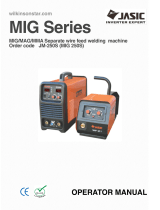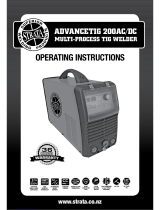15
STATEMENT OF WARRANTY
All new JASIC EVO20 welding, plasma cuers and mul-process machines are sold through our partner
Wilkinson Star Limited within the United Kingdom and Ireland shall be warraned to the original owner,
non transferable, against failure due to defecve materials or producon.
The warranty period is 5 years following the date of purchase and we recommend you register your
product online within 28 days of purchase.
The original invoice is documentaon for the standard warranty period. The warranty period is based
on a single shi paern.
Defecve units shall be repaired or replaced by the company at our workshop. The company may opt to
refund the purchase price (less any costs and depreciaon due to use and wear).
The company reserves the right to alter the warranty condions at any me with eect for the future.
A prerequisite for the full warranty is that products are operated in accordance with the operang
instrucons supplied, observing the relevant installaon and any legal requirements recommendaons
and guidelines and carrying out the maintenance instrucons shown in the operator manual. This should
be carried out by a suitably qualied competent person.
Warranty claims will only be accepted from authorised Jasic distributors and in the unlikely event of a
problem this should be reported to the technical support team to review the claim.
The customer has no claim to loan or replacement products whilst repairs are being performed.
The following falls outside the scope of the warranty:
• Defects due to natural wear and tear
• Failure to observe the operang and maintenance instrucons
• Connecon to an incorrect or faulty mains supply
• Overloading during use
• Any modicaons that are made to the product without the prior wrien consent
• Soware errors due incorrect operaon
• Any repairs that are carried out using non-approved spare parts
• Any transport or storage damage
• Direct or indirect damage as well as any loss of earnings are not covered under the warranty
• External damage such as re or damage due to natural causes e.g. ooding
• Warranty repairs carried out by non-authorised Jasic distributors.
NOTE:
Under the terms of the warranty, welding torches, their consumable parts, wire feed unit drive rolls
and guide tubes, work return cables and clamps, electrode holders, connecon and extension cables,
mains and control leads, plugs, wheels, coolant and accessories are covered with a 3 month warranty.
Jasic shall in no event be responsible for any third party expenses or expenses/costs or any indirect or
consequenal expenses/costs.
Jasic will submit an invoice for any repair work performed outside the scope of the warranty. A quotaon
for any non warranty will be raised prior to any repairs being carried out.
The decision about repair or replacement of the defecve part(s) is made by Jasic. The replaced part(s)
remain(s) Jasic property.
Warranty extends only to the machine, its accessories and parts contained inside. No other warranty is
expressed or implied. No warranty is expressed or implied in regards to the tness of the product for any
parcular applicaon or use.
If in our judgment you fail, or we suspect that you have failed, to comply with any term or provision of the
product warranty terms, we reserve the right to deny you access to our services (or any part thereof).
For further informaon on Jasic product warranty terms and product warranty registraon please visit:
www.jasic.co.uk/warranty-informaon
www.jasic.co.uk/warranty-registraon




























